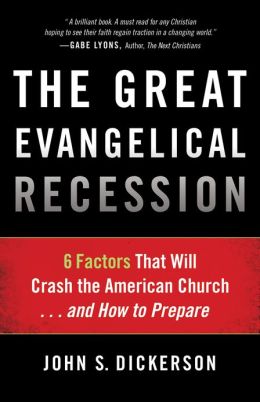 If you’ve been in church for awhile, you can sense it: the evangelical church is in a state of decline. Churches are struggling and dying off. Our influence is waning in culture. Our image in society is becoming increasingly jaded and extreme. In his book The Great Evangelical Recession, John S. Dickerson does an incredible job of giving the reader a comprehensive view of the evangelical church, pinpointing our weakest characteristics as a whole. According to Dickerson, there are six main areas where evangelicals are declining:
If you’ve been in church for awhile, you can sense it: the evangelical church is in a state of decline. Churches are struggling and dying off. Our influence is waning in culture. Our image in society is becoming increasingly jaded and extreme. In his book The Great Evangelical Recession, John S. Dickerson does an incredible job of giving the reader a comprehensive view of the evangelical church, pinpointing our weakest characteristics as a whole. According to Dickerson, there are six main areas where evangelicals are declining:
Six Trends of Decline:
- Inflated. Our numbers are too big. For years people threw out numbers stated that up to 40% of the population was evangelical, when the realistic number is somewhere between 7% and 9%. Our size isn’t what it seems. Here’s why that matters: each decade, we lose 2.6 million evangelicals. If the inflated number is true, then that would account for 2% of our number, not that big of a deal. But if we only make up 7% to 9% of the population, then losing 2.6 million means we’re losing 10% of our numbers each decade. Size matters. Sadly, we regularly inflate our numbers. I know a church that proudly boasts a membership of over 8,000, but only a quarter of that number actually attends. We’ve inflated our numbers.
- Hated. We’re known for what we’re against. You don’t have to look far in the news to see evangelicals coming out against this and that. As I wrote about in an earlier post, the number one thing that evangelicals are known for is that we hate homosexuals. We’re known for what we’re against.
- Dividing. There’s too much infighting within the evangelical community. Within the Southern Baptist Convention, we’re spending too much time fighting with each other over issues of predestination, taking our attention off the task at hand. Younger evangelicals are splitting away from the stranglehold the Republican party has been able to keep on evangelicals, leading to unnecessary political battles.
- Bankrupt. The giving generations are dying off. Even though younger generations are coming up to replace the older generation, they contribute at a much smaller level proportionally. Churches could see their funding cut by up to 70% in the next thirty years as the older generations die off.
- Bleeding. We’re losing our young people. We all know that. And we’re losing them at an alarming rate. Several research studies have shown that around 70% of millenials are leaving the church after high school. While it’s common knowledge that students leave during their college years, it’s a mistake to think that they all come back after they start a family; only 35% do. We’re losing the next generation of Christians.
- Sputtering. We’re not making disciples. Even as we’re losing our children, we’re failing to make new converts to the faith. That’s why evangelical numbers are slowly dwindling even though the overall population in America is soaring.
If that depresses you a little bit, it should. Evangelical churches are not in a good spot. May this be a wake up call for us to renew our dependence upon God and refocus our energies on the tasks that He would have for us. To mirror the six steps of decline, Dickerson offers six solutions for recovery.
Six Solutions for Recovery:
- Re-Valuing. We need to know our true numbers. We can’t grow if we don’t have a realistic baseline to work from.
- Good. This was my favorite chapter in the book. Instead of being known for what we’re against, we need to be known by our good deeds, as we’re told throughout Scripture. This means we need to serve more, reconcile more, and love more.
- Uniting. He makes a strong case for unity among churches. Unfortunately, it’s much easier said than done.
- Solvent. We must learn how to operate with a smaller financial footprint. Great words of advice in any age, but especially in today’s age of rapid change and instability.
- Healing. Pastors need to be healing, working to heal families and restore relationships.
- Re-Igniting. We must re-ignite the true workers of the ministry, the congregations of our churches. For too long, we’ve relied on pastors to do all the ministry, when it’s their job to equip the saints for works of service, not to do all the work themselves.
Overall, I thought this was a refreshing book for its insight and candor. As uncomfortable as the facts may be, facts are always better handholds for reality than fanciful wishes. Evangelical churches are struggling today. Our influence is waning. We can still grow and see the Kingdom of God take ground in America, but we must do things in a new way. We must be ready to pour new wine into new wineskins.
Simply said, the old way of doing church is no longer effective as a whole. We’re losing ground. We need a fresh wind of God’s Spirit in our churches. And we need churches willing to follow God’s leading into new territory. After all, there are still millions of people out there that need Christ’s forgiveness. We still have work to do.











